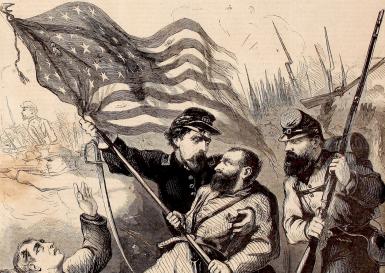Image source: about.com
Throughout history, there has been a change in the significance of the flag in a time of war. For the most part today, the flag is simply a symbol of the nation, used at government facilities. For our military troops, it acts an indicator of nationality. Previously though, in the beginning of the modern age, there was much more significance associated with the flag, or the standard, as it was commonly called. The flag was a symbol of identity and honor. Nowadays, the only time we see anything that is similar would be the flag bearers at the Olympic Opening Ceremonies leading the group of athletes from each country. Historically, the job of standard-bearer was one of pride and dignity, even though there was much danger associated with the role as well
This tradition of carrying the standard in the middle of battle dates back to the early Roman Empire. The Roman army was divided into regimented groups of set sizes. The smallest was the Century which was made of up 80-100 troops. A cohort was made up of 6 centuries, and a legion was made up of 10 cohorts, roughly 6000 troops. (Organization of the Roman Legion) The commanding officer of each century was called a centurion, and the most senior of the centurions would lead each cohort. The commanding officer of the First Cohort was the ranking officer in the legion. (Wikipedia) The First Cohort was also given the honor of carrying the standard for the legion as well as the Roman Aquila (eagle) which was a symbol of the Empire.
So what do these flags and history lessons have to do with Enterprise Architecture, you might ask?
Even though the standards were symbols of honor and pride, they had a much more practical use as well. The standard-bearer would always be part of the front line troops, and, many times, together with the commanding officers. The highly visible standard lifted high on the battlefield served as a rally point for all the surrounding troops. They could follow the movement of the flag in the midst of a chaotic and noisy battlefield. The standard gives visual directions to the rest of the troops. If your unit got out of formation, you could always survey the battlefield, find your standard, and work your way back to its location.
In the same way, a business standard is a reference point for decision making. The standard helps us to remain on track and gives us the ability to measure if our actions are on the proper course. Standards come in many variations as well. Some standards are hard lines that are absolute. Others act more as guidelines that help nudge us in the right direction. Most importantly, standards are not meant to be hindrances to getting business done. Instead, they are established boundaries which direct us toward common goals and allow us to operate most effectively.
